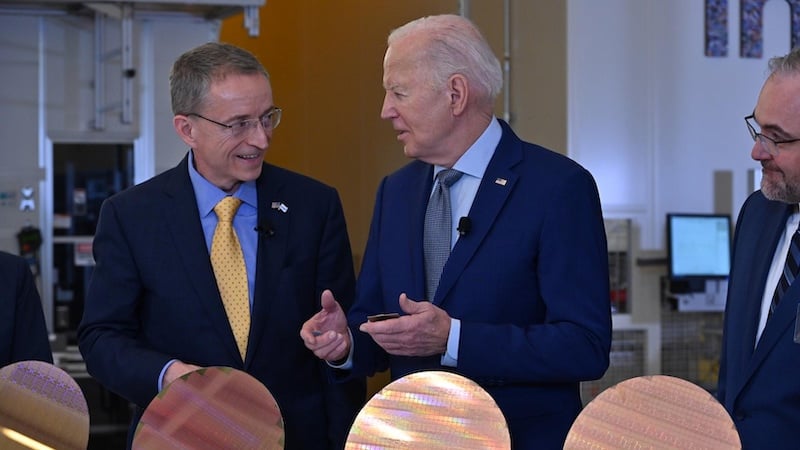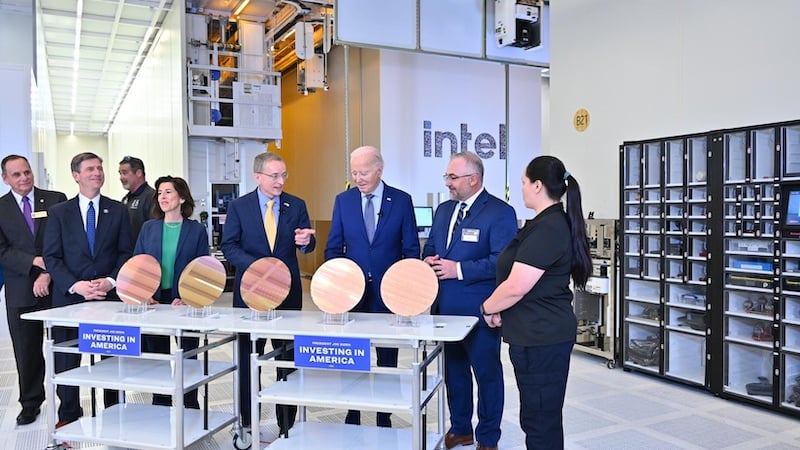Intel Granted $8.5 Billion to Boost Semiconductor Manufacturing
With the objective of strengthening the U.S.'s foothold in the semiconductor sector, Congress approved the CHIPS Act in July 2022. This legislation aims to enhance the country's competitiveness through targeted investments in semiconductor research, development, and production.

U.S. President Joe Biden (right) and Intel CEO Pat Gelsinger (left).
Intel, as the leading U.S. innovator and producer of sophisticated semiconductors, has announced its agreement with the U.S. government on initial terms for an $8.5 billion grant. This represents the most significant governmental disbursement in the history of the U.S. semiconductor industry.
How Intel Intends to Utilize the Grant
Intel has outlined plans to channel these funds into expanding its semiconductor fabrication and R&D efforts at its sites in Arizona, New Mexico, Ohio, and Oregon.
The company is set to channel over $32 billion into the construction of two new fabrication plants (fabs) and the refurbishment of its existing Fab 32 in Arizona. This is poised to enhance the production capacity of its 18A technology node. As per Intel's projections, this move should generate approximately 3,000 new positions within Intel, offer 6,000 construction-related jobs, and create several thousand additional jobs in the locality.
Furthermore, in New Mexico, Intel intends to direct $4 billion toward advancing its manufacturing capabilities for cutting-edge packaging technologies, among which includes Foveros, Intel's proprietary 3D packaging solution. These enhancements are anticipated to indirectly result in 700 new roles at Intel, 3,000 construction jobs, and another 3,500 jobs in various capacities.

Intel executives and members of the Biden administration.
In Ohio, Intel is poised to construct two new chip fabrication plants with an investment of $28 billion. Intel purports that these new facilities will generate the most sophisticated semiconductor processors within the U.S. and will augment Intel Foundry Services’ capacity for in-country chip production. These strategic investments are projected to introduce 3,000 new positions at Intel, create 7,000 jobs in the construction sector, and enhance Ohio's yearly economic output by $2.8 billion.
In Oregon, Intel's investment strategy involves an expenditure exceeding $36 billion to enlarge and upgrade its tech development sites. This venture will focus on pioneering the 18A and 14A technology nodes with the employment of the 'world's premier' high-numerical-aperture extreme ultraviolet (High-NA EUV) illumination technology. Among the cutting-edge technologies set to be developed in Oregon are PowerVia for backside power delivery, quantum computing technologies, and advancements in liquid cooling solutions.
The Significance of the $8.5 Billion Grant
Intel's receipt of the $8.5 billion grant takes a considerable slice of the CHIPS Act's $52.7 billion fund, carrying with it the federal government’s substantial expectations for impact.
This infusion of capital into Intel's manufacturing initiatives has the potential to propel the company back to its former place at the forefront of global high-tech semiconductor manufacturing and innovation. As Intel stands as the foremost semiconductor enterprise in the United States, its progression is deeply intertwined with the overall success of the national semiconductor industry.
In recent years, Intel has seen a decline in market share and relinquished its technological edge to the Taiwan Semiconductor Manufacturing Company (TSMC), attributed to be years ahead in adopting pioneering manufacturing techniques such as EUV. With TSMC's lead, major U.S. tech creators like Apple, Nvidia, and AMD have turned to TSMC for the production of their premier technology components.
Empowering the U.S. Semiconductor Sector
The semiconductor sector holds a pivotal place in the global arena from both political and economic perspectives.
President Biden considers the CHIPS Act grant a testament to the commitment to repatriate manufacturing capabilities for American innovations. The administration anticipates that this funding will escalate the U.S. stake in advanced semiconductor production from a current negligible percentage to 20% by 2030.
All images used courtesy of Intel.







